|
Home of the Old Ammo Guy's Virtual
Cartridge Trading Table
Picture
Page
December 2009
A Kynoch box 8mm Lebel cartridges......

This Kynock box of 8 x 50R French Lebel cartridges was sealed when
I received it from friend who was cleaning out his work area and decided he
had no more use for it. I have always considered unopened boxes to be much
less interesting than opened ones, so it didn't take me long to pull
out the pocket knife and carefully open the top flaps to see just what was
inside. The first thing to catch my attention was the old style flat nosed Balle M bullets, indicating the cartridges were probably made prior to 1898,
when the pointed ' Spitzer' Balle D bullet was adopted.
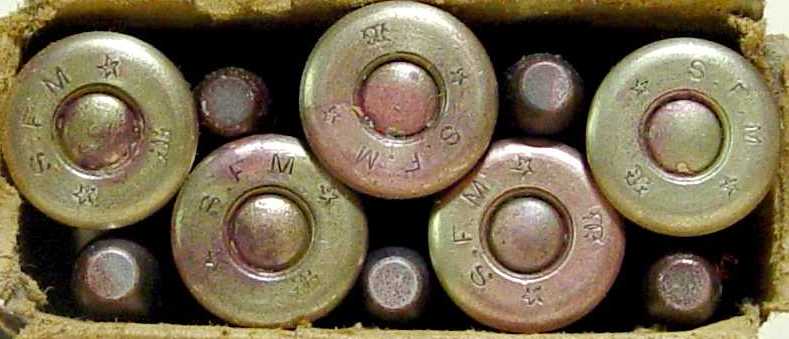 The second thing I noticed,
much to my surprise, was that the
cartridges didn't have the K * 8M/M * headstamps that I expected, but instead were
headstamped S.F.M * * with the back to back GG logo,
indicating production by the French ammunition maker Societe Francaise de
Munitions of Paris. SFM was formed from Gevelot and Gaupillat in 1886; the
GG logo in the headstamp represents the two earlier firms. The second thing I noticed,
much to my surprise, was that the
cartridges didn't have the K * 8M/M * headstamps that I expected, but instead were
headstamped S.F.M * * with the back to back GG logo,
indicating production by the French ammunition maker Societe Francaise de
Munitions of Paris. SFM was formed from Gevelot and Gaupillat in 1886; the
GG logo in the headstamp represents the two earlier firms.
Perhaps Kynoch contracted with SFM to produce cartridges for them at some
point, but I seriously doubt it, and until evidence surfaces of such a relationship between the two
companies, I will have to assume these cartridges were repackaged, either
prior to import to the US or after arriving in the US by someone who had an
empty box and 10 loose SFM cartridges, and no concern that the cartridges were
incorrect for the box. Here is one of the cartridges that should have been
in the box.
. 
.
.
Revisiting those early .32 and .38 S&W
cartridges....
S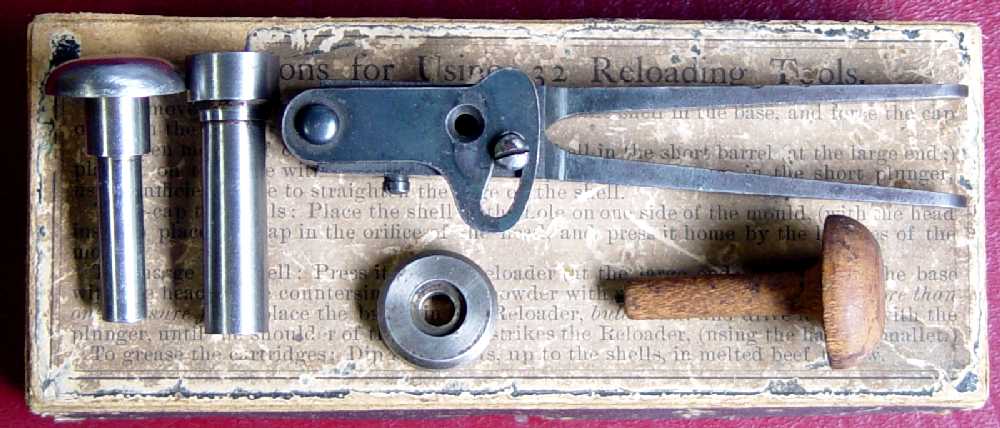 ome
months ago, I included pictures of and discussed a couple of sets of Smith &
Wesson reloading tools for the .32 S&W cartridge. These tools are pretty
basic, but serve their purpose quite well. The mold casts a bullet with a
single groove, of the early style referred to as outside lubed. When loaded,
the bullet groove ome
months ago, I included pictures of and discussed a couple of sets of Smith &
Wesson reloading tools for the .32 S&W cartridge. These tools are pretty
basic, but serve their purpose quite well. The mold casts a bullet with a
single groove, of the early style referred to as outside lubed. When loaded,
the bullet groove
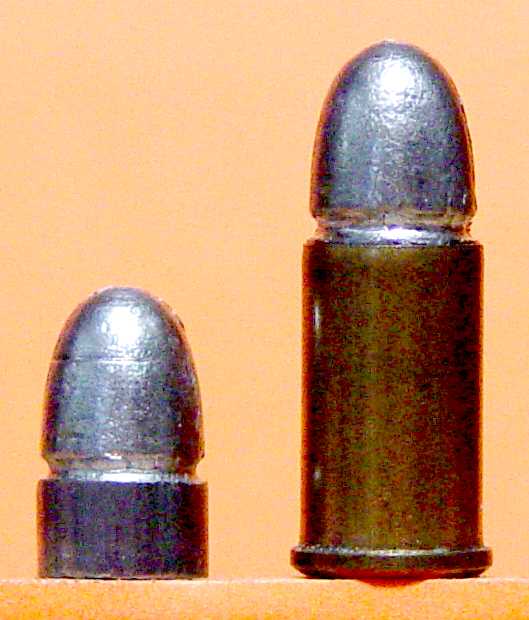 remains
outside the neck of the cartridge case, and would be filled with lubricant
during the reloading process. One of the bullets is shown on the left in
this picture, along with one that has been loaded in a case using the tools
shown above. remains
outside the neck of the cartridge case, and would be filled with lubricant
during the reloading process. One of the bullets is shown on the left in
this picture, along with one that has been loaded in a case using the tools
shown above.
Of note is the lack of crimping to the neck of the cartridge case after the
bullet is seated. These reloading tools rely on friction alone to hold the
bullet in place. When Daniel B. Wesson was developing the .38 Smith
& Wesson
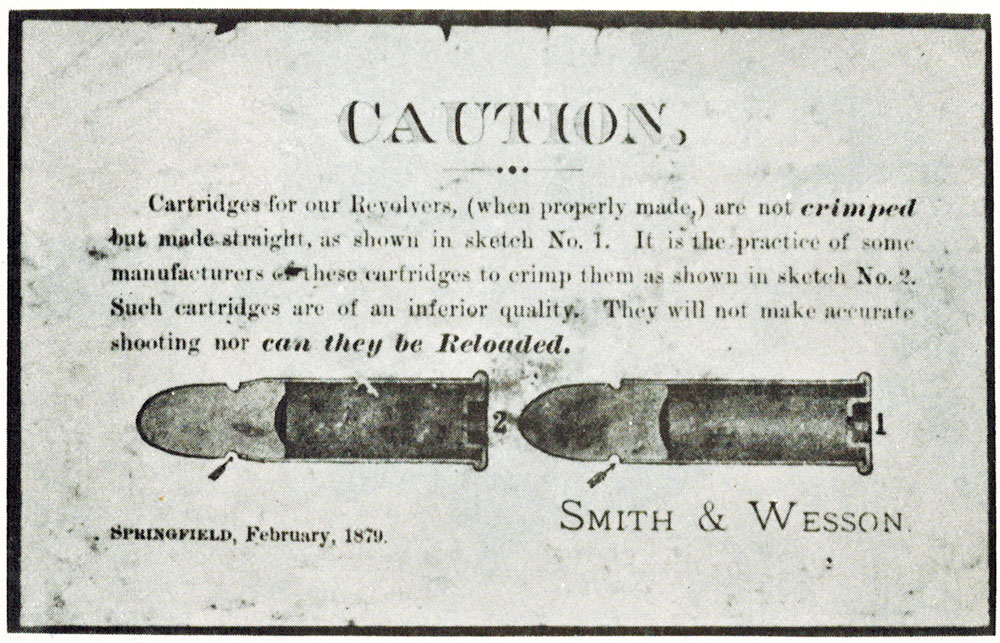 cartridge
in the 1875 or 1876, he was convinced that crimping the bullet in place reduced
accuracy and resulted in a cartridge case that could not be reloaded easily.
The company preferred that ammunition makers producing cartridges for
their revolvers not crimp the bullets in place, as noted on this cautionary
notice above taken from the cardboard box that held an early
Smith & Wesson .38 Single Action 1st Model (aka Baby Russian) revolver. The
first contract that Smith & Wesson entered into for the production of
.38 S&W cartridges for the Baby Russian revolver was in 1876 with the United
States Cartridge Company. One of these cartridge
in the 1875 or 1876, he was convinced that crimping the bullet in place reduced
accuracy and resulted in a cartridge case that could not be reloaded easily.
The company preferred that ammunition makers producing cartridges for
their revolvers not crimp the bullets in place, as noted on this cautionary
notice above taken from the cardboard box that held an early
Smith & Wesson .38 Single Action 1st Model (aka Baby Russian) revolver. The
first contract that Smith & Wesson entered into for the production of
.38 S&W cartridges for the Baby Russian revolver was in 1876 with the United
States Cartridge Company. One of these
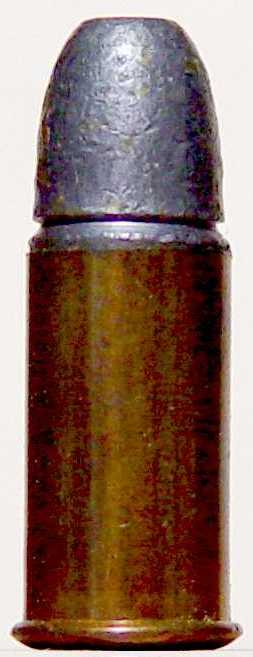 cartridges
and the cartridges
and the
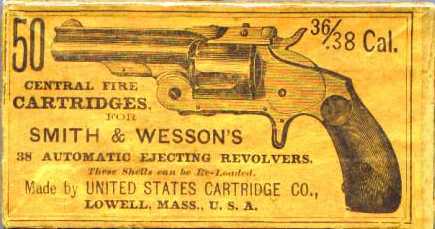 box
it would have been sold in are shown here. Based on the lack of a crimp on
this cartridge, it is obvious that USC Co followed Smith & Wesson's
specification regarding this detail when producing the contracted
ammunition. That this practice of not crimping the cases was not insisted on
by Smith & Wesson for very long is evident by the general lack of uncrimped
factory loaded Smith & Wesson cartridges that are found today. Other than
these early USC Co cartridges, I am not aware of any other .38 S&W or any
.32 S&W cartridges that were manufactured without a neck crimp. box
it would have been sold in are shown here. Based on the lack of a crimp on
this cartridge, it is obvious that USC Co followed Smith & Wesson's
specification regarding this detail when producing the contracted
ammunition. That this practice of not crimping the cases was not insisted on
by Smith & Wesson for very long is evident by the general lack of uncrimped
factory loaded Smith & Wesson cartridges that are found today. Other than
these early USC Co cartridges, I am not aware of any other .38 S&W or any
.32 S&W cartridges that were manufactured without a neck crimp.
The following four .38 S&W and .32 S&W boxes are the earliest I have in these
calibers. All four boxes were made by Union Metallic Cartridge Company, and
the 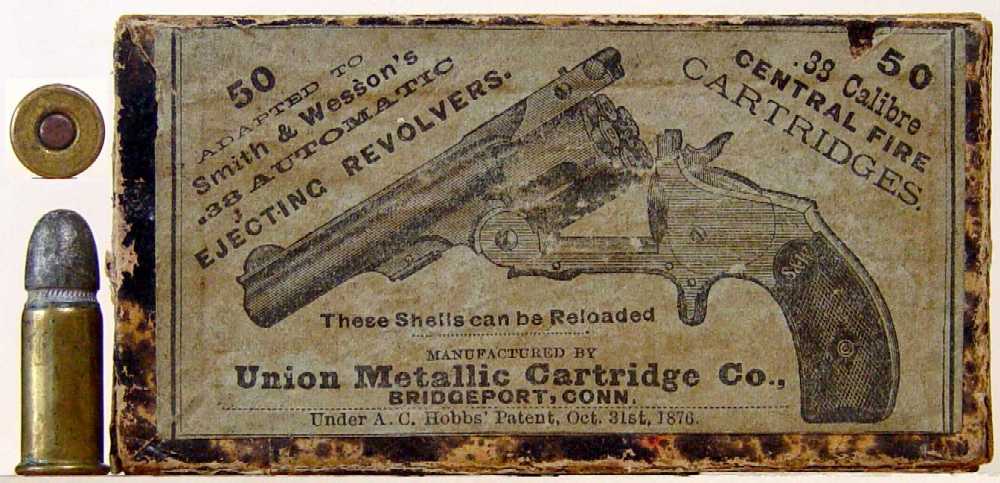 cartridges
in all four have the early outside lubed (grooved) bullets, as well as
crimped necks. This first box was probably made in 1877, based on the A. C.
Hobbs Oct 31st, 1876 patent date on the label, and the fact that the Baby
Russian shown on the label was produced in 1876 and 1877,
being discontinued with the introduction of Smith & Wesson's .38 cartridges
in all four have the early outside lubed (grooved) bullets, as well as
crimped necks. This first box was probably made in 1877, based on the A. C.
Hobbs Oct 31st, 1876 patent date on the label, and the fact that the Baby
Russian shown on the label was produced in 1876 and 1877,
being discontinued with the introduction of Smith & Wesson's .38
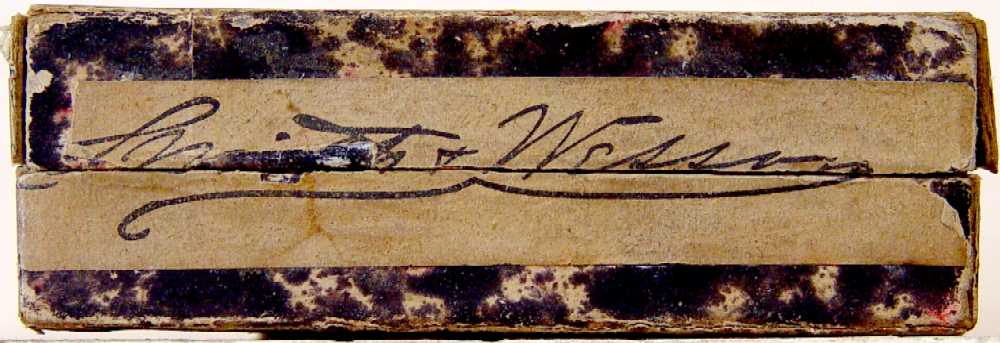 Single
Action 2nd Model revolver. With its introduction, the new model revolver
would also have replaced the old model on .38 S&W cartridge box labels
produced for the company. This box, as well as the other three shown below, has the
Smith & Wesson signature on its sealing label, indicating that the
ammunition was made for them to their specifications, but also Single
Action 2nd Model revolver. With its introduction, the new model revolver
would also have replaced the old model on .38 S&W cartridge box labels
produced for the company. This box, as well as the other three shown below, has the
Smith & Wesson signature on its sealing label, indicating that the
ammunition was made for them to their specifications, but also
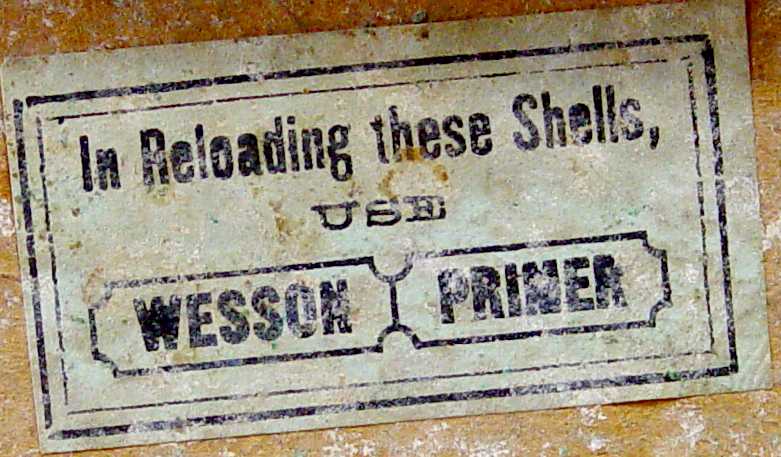 suggesting
that they were no longer specifying uncrimped necks on their ammunition as
early as 1877. The cartridges in this box are primed with the Wesson primer,
as noted on the small blue label that is attached to the inside the top. suggesting
that they were no longer specifying uncrimped necks on their ammunition as
early as 1877. The cartridges in this box are primed with the Wesson primer,
as noted on the small blue label that is attached to the inside the top.
This next box of .38 S&W cartridges has the .38 Single
Action 2nd Model revolver on the label. As discussed above, the 2nd Model
revolver was introduced in 1877. However, as indicated on the label, the
cartridges in this box use the U.M.C. No 0 primer, which was introduced in
1883, placing the production of this box sometime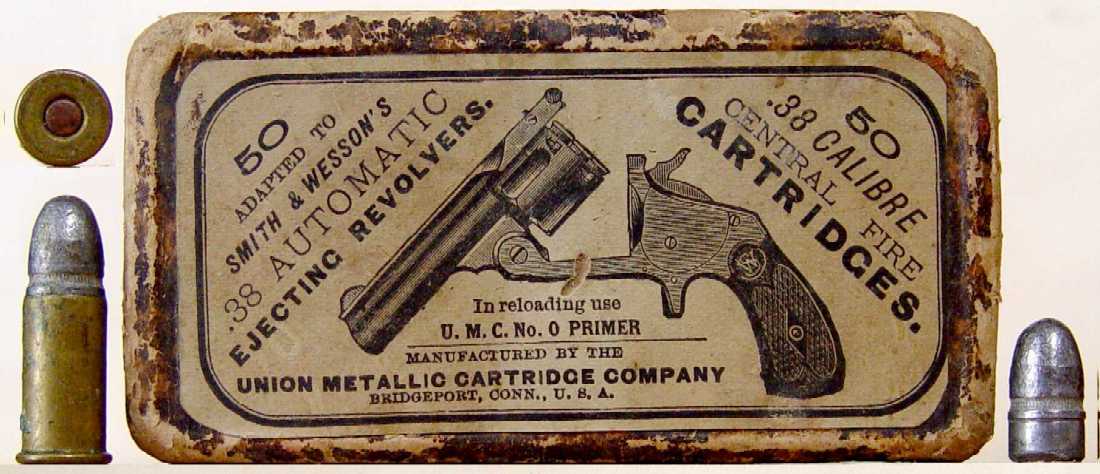
.
.
.
.
.
. between 1883 and about 1885, when headstamps were first applied by
U.M.C. on their centerfire cartridges. I removed one of the bullets,
which has only the single knurled grease groove, a cavity in the base, and
shows the effects of the case crimping, giving the bullet the appearance of
having a slightly heeled base.
The next two boxes contain early outside lubed .32 S&W cartridges. This
cartridge was also developed by D. B. Wesson and introduced in 1878 with the
Smith & Wesson Number 1 1/2 Single Action revolver. This revolver was quite
popular, and 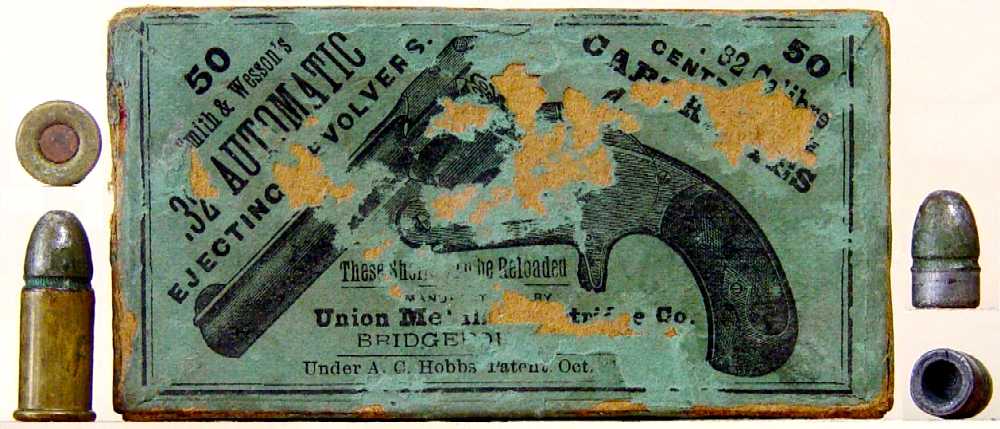 continued
in production until 1892. The label of this first .32 S&W box has an
illustration of the Number 1 1/2 Single Action revolver on it. The
cartridges in the box use the Wesson primer, as there is no mention of the
U.M.C. No 0 primer on the label. This would place the production of this box
sometime between 1878 and 1883. However, it is likely that it was made no
later than 1880, when Smith & Wesson introduced their .32 Double Action
First Model revolver, and would have begun illustrating their labels with
the new double action revolver for marketing purposes. continued
in production until 1892. The label of this first .32 S&W box has an
illustration of the Number 1 1/2 Single Action revolver on it. The
cartridges in the box use the Wesson primer, as there is no mention of the
U.M.C. No 0 primer on the label. This would place the production of this box
sometime between 1878 and 1883. However, it is likely that it was made no
later than 1880, when Smith & Wesson introduced their .32 Double Action
First Model revolver, and would have begun illustrating their labels with
the new double action revolver for marketing purposes.
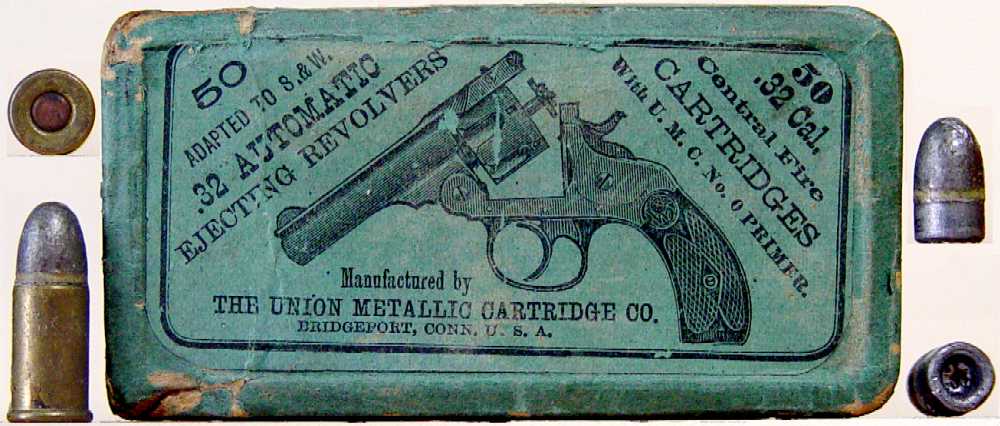 The
label of the next box of .32 S&W cartridges is illustrated with one of Smith
& Wesson's double action revolvers, this one the .32 Double Action Fourth
Model, which was introduced in 1883, coincidentally the year as the
appearance of the U.M.C. No 0 primer. Production of this box would have been
between 1883 and probably no later than the mid-1880s, when the company
added a logo to the labels of their center fire ammunition, which consisted
of the letters U.M.C. in an elongated (racetrack shaped) oval. The
label of the next box of .32 S&W cartridges is illustrated with one of Smith
& Wesson's double action revolvers, this one the .32 Double Action Fourth
Model, which was introduced in 1883, coincidentally the year as the
appearance of the U.M.C. No 0 primer. Production of this box would have been
between 1883 and probably no later than the mid-1880s, when the company
added a logo to the labels of their center fire ammunition, which consisted
of the letters U.M.C. in an elongated (racetrack shaped) oval.
I also removed bullets from cartridges from each of the .32 S&W boxes to
determine if they were basically the same as the .38 bullet and the bullets
that I had cast with the mold from the set of loading tools. The pulled .32
bullets were just smaller versions of the .38 bullets, with the single
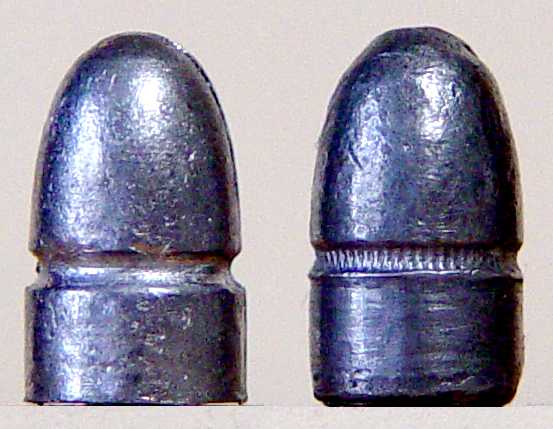 knurled
grease groove and the base cavity. All of the bullets in the boxes had a
coating of hard waxy grease, which can be seen in the pictures above.
The .32 bullets from the boxes weigh about 88 grains, while my cast bullets
are about 93 grains. This picture shows one of the cast bullets on the left
with one of the pulled bullets that has had its coating of waxy grease
removed. knurled
grease groove and the base cavity. All of the bullets in the boxes had a
coating of hard waxy grease, which can be seen in the pictures above.
The .32 bullets from the boxes weigh about 88 grains, while my cast bullets
are about 93 grains. This picture shows one of the cast bullets on the left
with one of the pulled bullets that has had its coating of waxy grease
removed.
.
.
An interesting headstamp on a .30-06 M1909 blank.....
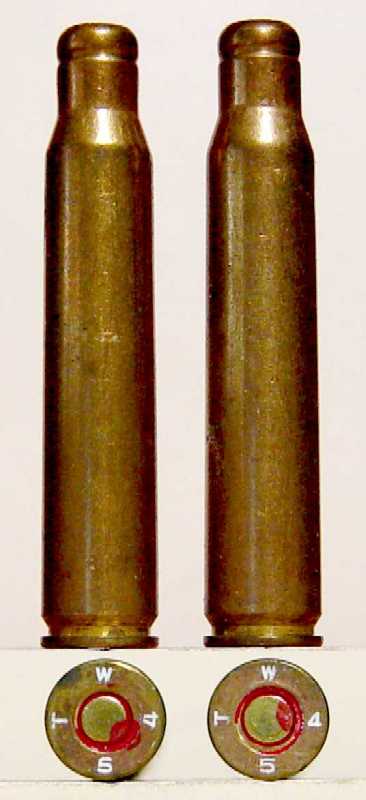
Here are a couple of blanks that utilized cases
made in 1954 at the Twin Cities Ordnance Plant in Minneapolis, Minnesota.
The one on the left is headstamped as expected, with the letters and numbers
oriented to be read in the 12 and 6 o'clock positions, respectively. On the
one on the right, the '4' is rotated 90 degrees, as well as being in a
different font.
I posted a question about this odd headstamp on the IAA Cartridge Forum,
and received this response from Frank Hackley, one of the authors of
History of Modern U.S. Military Small Arms Ammunition:
"M1909 blanks made during this period were authorized to be made from
"Second Class" cases, which includes minor imperfections that do not reduce
form, fit or function. This case was probably culled out of normal
production during visual inspection and ear-marked for M1909 blank use.
During the Korean War production period, Twin Cities did not have an "in
house" tooling capability and thus was forced to sub-contract all their
perishable tooling needs - including case heading bunters. To save time and
money some contractors used bunters with "embedded" letters and numbers and
I assume it was one of these that produced the mis-placed 4 in a different
font. There are other inconsistencies in TW headstamps during this period,
including the placement, style and spacing of letters and numbers, which we
assume to be caused by the different tooling makers not strictly following
the contract specifications for bunters."
For those who are waiting for Volume 3 of History of Modern U.S.
Military Small Arms Ammunition, Mr. Hackley included the following bit
of welcome news:
"Regarding HWS Vol. III, the final draft is completed and Gene Scranton is
busy working on the remaining illustrations - as of now we have over 900
drawings, 400 photographs and 1300 typed pages of manuscript. Under the
circumstances, it is possible that Vol. III will have to be published in two
parts, because of its size."
.
.

|

 cartridges
and the
cartridges
and the
 box
it would have been sold in are shown here. Based on the lack of a crimp on
this cartridge, it is obvious that USC Co followed Smith & Wesson's
specification regarding this detail when producing the contracted
ammunition. That this practice of not crimping the cases was not insisted on
by Smith & Wesson for very long is evident by the general lack of uncrimped
factory loaded Smith & Wesson cartridges that are found today. Other than
these early USC Co cartridges, I am not aware of any other .38 S&W or any
.32 S&W cartridges that were manufactured without a neck crimp.
box
it would have been sold in are shown here. Based on the lack of a crimp on
this cartridge, it is obvious that USC Co followed Smith & Wesson's
specification regarding this detail when producing the contracted
ammunition. That this practice of not crimping the cases was not insisted on
by Smith & Wesson for very long is evident by the general lack of uncrimped
factory loaded Smith & Wesson cartridges that are found today. Other than
these early USC Co cartridges, I am not aware of any other .38 S&W or any
.32 S&W cartridges that were manufactured without a neck crimp.  cartridges
in all four have the early outside lubed (grooved) bullets, as well as
crimped necks. This first box was probably made in 1877, based on the A. C.
Hobbs Oct 31st, 1876 patent date on the label, and the fact that the Baby
Russian shown on the label was produced in 1876 and 1877,
being discontinued with the introduction of Smith & Wesson's .38
cartridges
in all four have the early outside lubed (grooved) bullets, as well as
crimped necks. This first box was probably made in 1877, based on the A. C.
Hobbs Oct 31st, 1876 patent date on the label, and the fact that the Baby
Russian shown on the label was produced in 1876 and 1877,
being discontinued with the introduction of Smith & Wesson's .38